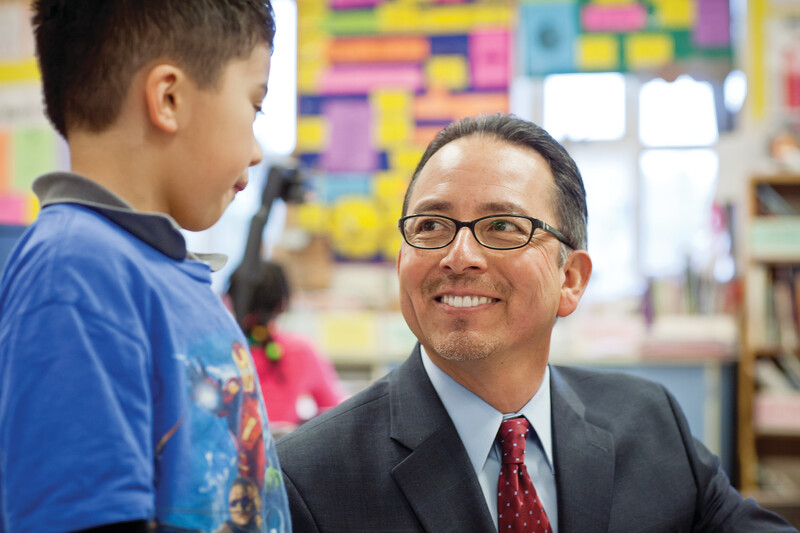We principals are all too familiar with the situation of not having sufficient resources to meet the needs of our students and staff. How can we solve this problem?
At the Graham & Parks Alternative Public School in Cambridge, Massachusetts, we have aggressively sought out additional resources to enrich our school and better provide for our students' needs. We have recruited volunteers from the community and from area colleges and universities; built alliances with local organizations; and written and obtained grants from local, state, and national agencies. Here are some examples of the kinds of resources that we have brought into our school.
Volunteers
Our school has long benefited from the help of volunteers in our community. For the past 10 years, we have recruited volunteers from Harvard University's Kennedy School of Government who perform tasks determined both by their interests and by the class's needs. The volunteers work with small math or reading groups, sit and read individually with students, and help integrate art and music into class learning projects. They also coach students in our after-school sports program, tutor students outside of school, and work in our homework centers.
- The national Foster Grandparent Program places senior citizens in schools to work with K–2 students on a one-on-one basis.
- Our Intergenerational Reading Program trains retired professionals as reading tutors for 1st and 2nd graders.
- CitySteps, now a city-wide program, is a dance/movement project started in our school 10 years ago by Harvard students.
CitySites: A Community Partnership
One of our most successful programs is CitySites. Each year, more than 50 city businesses and agencies “hire” 7th and 8th graders for a week, providing the students with meaningful work for six hours a day and assigning each student a mentor to provide guidance and feedback. The organizations vary; participants have included the local newspaper, the city police department, and a food bank. In addition to working for their sponsors, students also study their organizations' history, purpose, and contributions to the city. The CitySites project actively involves students in their learning and teaches them firsthand about civic and community issues, business, and other real-world topics.
For the project's culminating grand exhibition night, students present what they learned and accomplished at their work sites to peers, parents, faculty, and community leaders.
Foundations and Grantmakers
During the 29 years of our school's existence, we have received more than $6 million in grants from the state and federal government and from private foundations for a wide range of programs. For example, a local foundation provided funds to replace our outdated computer-assisted instruction lab with 27 networked iMacs and new software, and has also funded after-school homework centers, summer programs, and technical training for our staff.
Massachusetts, through the Department of Education, provides funding to encourage voluntary desegregation. These funds have paid for instructional aides, staff developers, learning materials, and parent coordinators. The state also provided magnet school funding, which we used to develop innovative programs, to employ more people to work directly with students, and to help parents become more involved in all aspects of the school.
Staff development has always been one of our school's major priorities and is a resource well worth investing in: Enthusiastic teaching breeds enthusiastic learning. From the mid-1970s through the early 1990s, grants from the Massachusetts Department of Education allowed us to have a full-time, on-site staff developer to work with teachers and the entire school staff on curriculum, learning, and school climate issues.
Other institutions have given us access to additional sources of federal funding. For 10 years, we have worked with the Technical Education Resources Center on a science project called Chèche Konnen, which means “search for knowledge” in Haitian Creole. The Chèche Konnen Center, in collaboration with Cambridge and Boston public schools, conducts classroom-based research on teaching and learning science in Haitian Creole and Spanish bilingual classrooms. This staff development program helps teachers develop sense-making approaches to teaching science, especially with bilingual students, and provides such assistance as ongoing discussion groups with teachers involved in the project; weekly on-site staff development support; and videotaping and transcriptions of lessons. The project is funded with a National Science Foundation grant.
In another National Science Foundation-sponsored project, we have collaborated with the School of Education at the University of Massachusetts—Boston on a professional development program. This program brings us student teachers and interns, many of whom join us full-time for the entire school year. The university also offers on-site courses tailored to our staff's needs, and our teachers have worked with the university staff to help them redesign their college courses. Clearly, this arrangement brings important resources into the school—both for the students and for our teachers.
Project Zero, an educational research group at Harvard's Graduate School of Education, has helped middle school teachers develop a portfolio process for all subject areas. For example, at the end of 8th grade, students participate in a portfolio review and demonstrate what they have learned to a panel of educators. And our humanities teachers have worked with the Underground Railroad Theatre to help students write and produce original plays based on what they are studying in class. These collaborations with external agencies clearly enrich teachers' practice, offering them ideas and resources and helping them evaluate and reflect on their work. And in turn, this helps the students.
Schools with limited resources can often find what they need in their communities. Every community has untapped resources; retired people, businesses, public agencies, and colleges and universities are often available and willing to volunteer. Taking advantage of these resources can help schools create a richer learning environment for students and teachers alike.



